03/20/12: NEW Liquid Nitrogen Tank
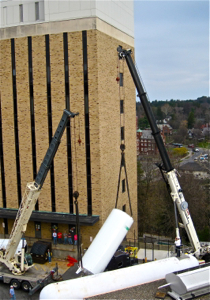
New liquid nitrogen tank being installed for testing SRF cavities at Newman Lab.
Today a new liquid nitrogen tank was installed for testing of SRF cavities at Newman Lab.
We are using liquid nitrogen for cooling of the 80 Kelvin thermal shields of our cryogenic dewars, and for re-liquifying the helium used for cooling of the SRF cavities to a few Kelvin in the dewars during performance testing.
The new tank has about four times the volume of the old liquid nitrogen tank, and will allow us running our helium refrigerator system continuously, thus supporting testing more SRF cavities at Newman Lab.
03/16/12: Dragon Day
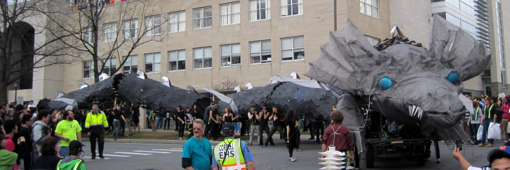
Dragon Day 2012 at Cornell.
Dragon Day is an annual event at Cornell University. It occurs each year on the Friday before the university's spring break, in mid-March. The center of the event is the procession of a dragon, created by first-year architecture students at the College of Architecture, Art, and Planning, past the College of Engineering and into the Arts Quad. The first event was in 1901.
03/12/12: Mushroom TE Sample Host Cavity Field Passes 500 Oe Milestone
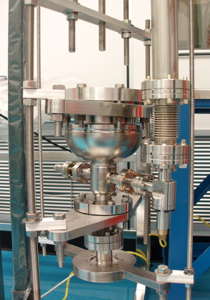
Mushroom TE sample host cavity on its cryogenic insert.
Our new mushroom TE-mode sample host cavity passed an important milestone last week by reaching magnetic fields of up to 600 Oe on its sample plate.
This cavity was developed and tested by our grad student Yi Xie, and allows measuring the RF surface resistance of flat superconducting sample plates as function of temperature and surface magnetic field. THe system is now ready for exploring the performance of new RF superconductors like Nb3Sn and MgB2, and for systematically studying various effects related to the SRF performance of Niobium.
02/15/12: Cornell-ERL Main-Linac Cavity Reaches Performance Specs in Cryomodule Test

Horizontal test cryostat.
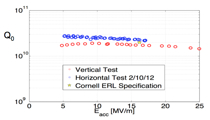
Plot of Quality Factor versus Accelerating Gradient at 1.8 K for the ERL main linac prototype 7-cell cavity installed in the Horizontal Test Cryomodule. The star marks the ERL main linac quality factor and accelerating gradient design specification.
The first ERL-prototype accelerating cavity achieved a quality factor of Q0=2.3x1010 at 16MV/m and 1.8K in a horizontal test cryomodule, surpassing the ERL's requirement. The superconducting cavities need to be extraordinarily efficient for an ERL linac, since its 5 GeV SRF main linac is operated in continuos mode. Increased quality factors go along with decreased energy consumption of an SRF linac. The achievement of high Q is therefore relevant not only to Cornell's ERL but also to Project-X at Fermilab, to the Next Generation Light Source, to Electron-Ion colliders, spalation-neutron sources, and accelerator-driven nuclear reactors.
The test of this cavity was done by our graduate students Nick Valles, Sam Posen, and Dan Gonnella.
01/11/12 Cornell ERL Horizontal Test Cryomodule Completed
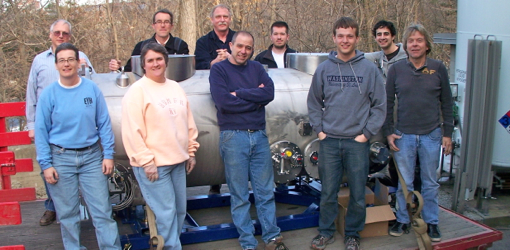
THe completed Cornell ERL Horizontal Test Cryomodule (HTC).
The Cornell ERL SRF team has completed this week the assembly of a Horizontal Test Cryomodule (HTC), hosting the first prototype of the man linac 7-cell SRF cavity. The main focus of testing this cavity and cryomodule will be on showing that a high intrinsic quality factor Q can be maintained in horizontal tests after the cavity has been equipped with its helium vessel, RF couplers and HOM absorbers.
Increased quality factors go along with decreased energy consumption of an SRF linac, particularly if it accelerates continuous beams. The achievement of high Q is therefore relevant not only to Cornell's ERL but also to Project-X at Fermilab, to the Next Generation Light Source, to Electron-Ion colliders, spalation-neutron sources, and accelerator-driven nuclear reactors.
10/15/2011: Cornell-ERL Main-Linac Cavity Reaches Performance Specs in Vertical Test
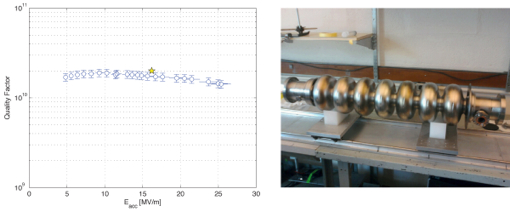
At left: Plot of Quality Factor versus Accelerating Gradient at 1.8 K. The star marks the ERL main linac quality factor and accelerating gradient design specification. At right: Cornell's 7-cell superconducting RF cavity.
Cornell has reached performance specifications for the ERL's main-linac cavities in a vertical test. This cavity has been completely designed, constructed, and tested in Cornell's SRF group. The cavity shape has been optimized by our grad student Nick Valles to allow 200mA in the ERL linac, even with realistic construction errors. Starting with bare niobium sheets, the SRF team constructed this cavity from scratch, carefully controlling dimensions along the way. This led to a field flatness of 85% without tuning, an exceedingly high number indicating exceptional production accuracy. Chemical cleaning has also been performed in house.
This first ERL-main-linac cavity has now been tested by our grad students Sam Posen and Nick Valles at operation temperature and operation field levels, where it achieved the required quality factor Q of about 2x1010. While reaching this performance specification already with the first prototype in a vertical test is a promising achievement, it will now have to be shown that this quality factor can be maintained in horizontal tests after the cavity has been equipped with its helium vessel, RF couplers and HOM absorbers. A horizontal test is already being developed and is planned for early 2012.
Increased quality factors go along with decreased energy consumption of an SRF linac, particularly if it accelerates continuous beams. The achievement of high Q is therefore relevant not only to Cornell's ERL but also to Project-X at Fermilab, to the Next Generation Light Source, to Electron-Ion colliders, spalation-neutron sources, and accelerator-driven nuclear reactors.
The ERL's specifications for accelerating gradient of 16MV/m with a Q of 2x1010 at a temperature of 1.8K were achieved and an extended parameter range was explored: gradients to 25MV/m without significant field emission, Qs of nearly 3x1010, and temperatures down to 1.6K.
09/09/2011: Cornell SRF Graduate Student Receives Poster Award
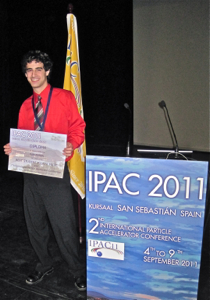
Graduate student Sam Posen at International Particle Accelerator Conference 2011 in San Sebastian, Spain.
We are proud to announce that Sam Posen was awarded one of the two Best Student Poster Prizes at the International Particle Accelerator Conference 2011 in San Sebastian, Spain. More than 130 other students participated in the competition.
His poster presents his work on Nb3Sn as an alternative superconductor for accelerating cavity applications. A defect-free cavity coated by Nb3Sn has the potential to achieve nearly twice the accelerating gradient of a standard niobium cavity and to require significantly lower cryogenic costs to operate. Sam has designed and built an apparatus to fabricate Nb3Sn, and surface analyses he performed on the first samples indicate that he has produced uniform Nb3Sn with the perfect composition for an SRF cavity.
The poster also presents the work of fellow SRF group graduate student Yi Xie in the design and fabrication of two sample-testing cavities.
Sam is in his third year of PhD studies in our group. His adviser is Matthias Liepe.
09/09/11: International Particle Accelerator Conference 2011

View of San Sebastian, Spain, where the 2011 International Particle Accelerator Conference was held this week.
This week Sam and Matthias attended the 2011 International Particle Accelerator Conference in San Sebastian, Spain. Not only did we get a change to present our work during talks and poster sessions, but Sam also was awarded one of the two Best Student Poster Prizes of the conference. We also got to see a see beautiful San Sebastian. Our papers from the workshop can be found here.
08/25/2011: First Cavity for the Cornell-ERL Main Linac
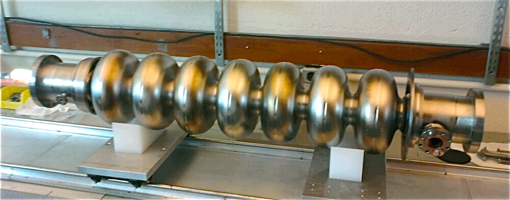
Cornell's 7-cell superconducting RF cavity.
Cornell has completed construction of the first SRF cavity for Cornell-ERL's main linac. This cavity has been designed by our grad student Nick Valles and has been completely fabricated in Cornell's SRF group. The computer-design process has led to a cavity shape and a Higher-Order-Mode (HOM) absorber that allow for the large beam current in the main linac of 200mA. In addition, the cell-to-cell coupling has been optimized to make the HOM absorption minimally dependent on construction errors. This optimized cavity shape has been used to construct this first Cornell-ERL cavity from scratch, starting from bare niobium sheets. All construction steps, forming, electron-beam welding, and quality control by a CMM and by frequency test techniques have been performed in the SRF laboratory. Also, chemical cleaning procedures were applied locally.
Subsequent steps will be to measure the quality factor of this cavity at an operation field of about 16MV/m in a vertical test setup, and then to equip the cavity with its helium vessel, its coupler and HOM absorber, and to insert it into a horizontal test cryostat to see if the quality factor will remain as large as in the vertical arrangement.
07/29/2011: Cornell SRF Graduate Student Receives Poster Award
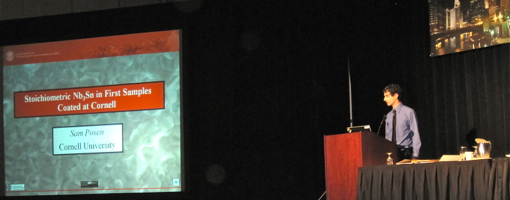
Cornell Grad Sam Posen, presenting his work on Nb3Sn after receiving the Most Outstanding Student Poster Award at the SRF 2011 conference in Chicago.
We are proud to announce that Sam Posen is the winner of the Most Outstanding Student Poster Award at the SRF 2011 conference in Chicago.
His poster presents his work on Nb3Sn as an alternative superconductor for accelerating cavity applications. A defect-free cavity coated by Nb3Sn has the potential to achieve nearly twice the accelerating gradient of a standard niobium cavity and to require significantly lower cryogenic costs to operate. Sam has designed and built an apparatus to fabricate Nb3Sn, and surface analyses he performed on the first samples indicate that he has produced uniform Nb3Sn with the perfect composition for an SRF cavity.
Sam is in his third year of PhD studies in tour group. His advisor is Matthias Liepe.
07/29/11: 2011 International Conference on RF Superconductivity

View of Chicago, where the 2011 International Conference on RF Superconductivity was held this week.
This week Nick, Sam, Yi, and Matthias attended the 2011 International Conference on RF Superconductivity in Chicago. Not only did we get a change to present our work during talks and poster sessions, but Sam also was awarded the Most Outstanding Student Poster Award of the conference. Our eleven papers from the workshop can be found here. Both Nick and Matthias gave invited talks during the conference, and Sam presented his work on Nb3Sn after receiving the Most Outstanding Student Poster Award. Our talks can be found here.
05/02/2011: Cornell Produces Stochiometric Nb3Sn
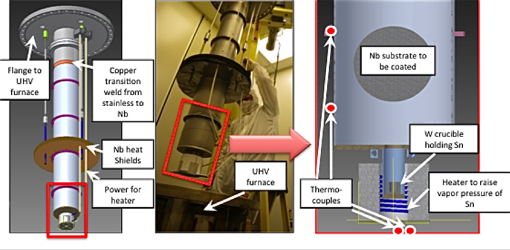
The Nb3Sn coating chamber. Left: Design of the reaction chamber. Middle: The Nb3Sn coating chamber being inserted into the UHV furnace. Right: cross section showing the tin crucible surrounded by the heater and the Niobium substrate suspended above. A small tin crucible is heated to produce tin vapor inside the chamber, which is then coating the Niobium sample plate and defused into the plate to produce a thin layer of Nb3Sn.
Our grad student Sam Posen has developed and fabricated a reaction-chamber insert for our existing high temperature (>1400 C) vacuum furnace and produced first Nb3Sn films on Niobium sample plates by the vapor diffusion method .
The quality of the coatings achieved was analyzed in various ways, including measuring the EDX spectrum of the Nb3Sn coating to determine its composition, XPS scans to determine the thickness of the coating, SEM measurements to determine grain size and structure, and measuring its critical temperature. All results show that Nb3Sn was produced with ideal stoichiometry for RF applications with excellent uniformity over the sample.
04/01/11: 2011 Particle Accelerators Conference

View of Manhattan, NY, where the 2011 Particle Accelerators Conference was held this week.
This week Matthias attended the 2011 Particle Accelerators Conference in New York City to present an invited talk on SRF for the Cornell Energy Recovery Linac. A copy of the talk can be found here. Our papers from the workshop can be found here.
03/12/2010: Temperature dependence of the superheating field in niobium measured
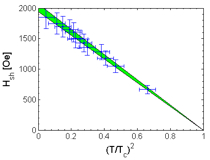
Plot of the superheating field data versus (T/Tc)2, where the sample's critical temperature was Tc=8.83 K. The green cone shows the Ginzburg-Landau prediction. The cone's width results from measurement uncertainty in a model parameter. The measured data agrees well with the model to within measurement errors.
Our group has recently made breakthrough measurements of the fundamental properties of the BCS superconductor Niobium, a material commonly used in microwave cavities for superconducting accelerators. Professor Matthias Liepe along with graduate student Nick Valles, has measured Niobium's superheating field in the full temperature range between 1.8K and its critical temperature. The superheating field is the maximum magnetic field up to which the Meissner state of a superconductor can exist as a metastable state. Above the superheating field, the superconductor starts to transition into the normal conducting state. They found that a simple phenomenological theory accurately (within the 10% error bars of our measurements) models the behavior of the superheating field down to temperatures of 1.8 K, which for the first time includes the region at which most superconducting RF accelerators operate (about 2K).
This research is important, because it marks the first time that scientists have been able to measure this fundamental property of Niobium over the full temperature range with certainty - made possible with the use of oscillating superleak transducers, another Cornell innovation. This critical magnetic field determines the ultimate limit for the accelerating field gradient of Niobium superconducting cavities, and suggests that for very pure Niobium, surface fields of up to 2400 Oe may be achievable, which is important for next generation accelerators such as the International Linear Collider.
02/16/2010: Improved ERL injector cryomodule completed by the SRF group
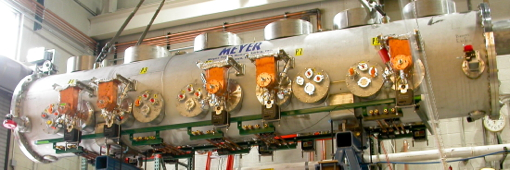
The Cornell ERL injector SRF cryomodule.
Cornell's prototype ERL injector cryomodule has been reworked to include two important improvements. (1) The Q0 of the superconducting two cell cavities was only approximately 4x109, instead of the anticipated 2x1010. Cavities were therefore cleaned with high-pressure water, and some by buffered chemical polishing. (2) The 6 higher-order mode absorbers had been shown to charge up during electron-beam operation, leading to unintended deflections of the beam. These absorbers therefore had to be simplified, so they do not expose chargeable surfaces to the beam. Furthermore, their design was changed so strong tensions are avoided under cool down.
Improving this cryomodule has been a large effort at the SRF laboratory and has taken approximately 4.5 months. However, on Monday February 8th, the complete accelerating module has been moved from the SRF group to the accelerator test area in Wilson laboratory where it will accelerate electron beam about one month later.
01/11/2010: Very Low Resistance Achieved in a Re-entrant Niobium Cavity
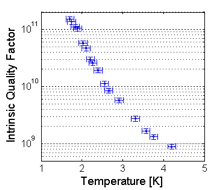
Quality factor of the cavity as a function of temperature. The cavity had a quality factor of 1.5*1011 at 1.7 K. Data was taken at an accelerating gradient of 6 MV/m.
A cavity with a very low residual resistance was recently measured at Cornell by graduate student Nick Valles. The re-entrant Niobium cavity received a low temperature vertical electropolish and had a surface resistance of only (0.92 ± 0.23) nΩ, a value among some of the lowest recorded. The cavity's intrinsic quality factor was 1.5x1011 at 1.7 K and an accelerating gradient of 6.2 MV/m. This cutting-edge result illustrates the ongoing effort at CLASSE to be at the forefront of superconducting RF physics, where the development of very high Q cavities is crucial for the efficient operation of next generation CW SRF light sources or particle accelerators such as Cornell's Energy Recovery Linac or Fermilab's ProjectX.
More News Items
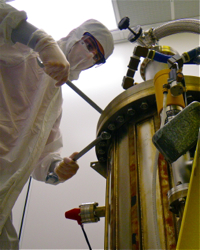
High temperature vacuum furnace for the production of Nb3Sn via vapor diffusion.
